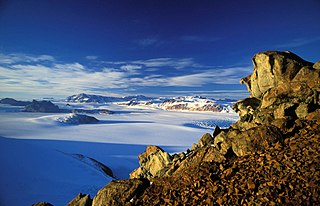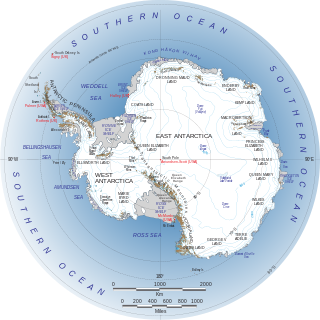
Nothofagus, also known as the southern beeches, is a genus of 43 species of trees and shrubs native to the Southern Hemisphere in southern South America and Australasia. The species are ecological dominants in many temperate forests in these regions. Some species are reportedly naturalised in Germany and Great Britain. The genus has a rich fossil record of leaves, cupules, and pollen, with fossils extending into the late Cretaceous period and occurring in Australia, New Zealand, Antarctica, and South America. In the past, they were included in the family Fagaceae, but genetic tests revealed them to be genetically distinct, and they are now included in their own family, Nothofagaceae.

The Magellanic subpolar forests are a terrestrial ecoregion of southernmost South America, covering parts of southern Chile and Argentina, and are part of the Neotropical realm. It is a temperate broadleaf and mixed forests ecoregion, and contains the world's southernmost forests.

The Transantarctic Mountains comprise a mountain range of uplifted rock in Antarctica which extend, with some interruptions, across the continent from Cape Adare in northern Victoria Land to Coats Land. These mountains divide East Antarctica and West Antarctica. They include a number of separately named mountain groups, which are often again subdivided into smaller ranges.

West Antarctica, or Lesser Antarctica, one of the two major regions of Antarctica, is the part of that continent that lies within the Western Hemisphere, and includes the Antarctic Peninsula. It is separated from East Antarctica by the Transantarctic Mountains and is covered by the West Antarctic Ice Sheet. It lies between the Ross Sea, and the Weddell Sea. It may be considered a giant peninsula, stretching from the South Pole towards the tip of South America.

Nothofagus cunninghamii, the myrtle beech, is an evergreen tree native to Tasmania and Victoria, Australia. It grows mainly in the temperate rainforests, but also grows in alpine areas. It is not related to the Myrtle family. It is often referred to as Tasmanian myrtle within the timber industry. N. cunninghamii was proposed to be renamed Lophozonia cunninghamii in 2013. There has been some controversy over the change in name from Nothofagus to Lophozonia.

Nothofagus gunnii, the tanglefoot- or deciduous beech, or Australian beech, is a deciduous shrub endemic to the highlands of Tasmania, Australia. It was discovered in 1847 by R.C Gunn and evidence exists that it once lived in Antarctica. N. gunnii is a small woody tree with a shrubby appearance known to grow up to 10 metres (33 ft). It lives only on mountains due to temperature limitations within the Tasmanian maritime climate and can survive up to heights of 1,600 metres (5,200 ft). It grows in alpine and sub-alpine regions in the central portions of the state but is absent from the coast zones. Though capable of reaching the size of a small tree, it rarely exceeds 10 metres (33 ft) in height, instead growing as a thick shrub or as a woody ground cover hence its common name of "tanglefoot".

East Antarctica, also called Greater Antarctica, constitutes the majority (two-thirds) of the Antarctic continent, lying on the Indian Ocean side of the continent, separated from West Antarctica by the Transantarctic Mountains. It lies almost entirely within the Eastern Hemisphere and its name has been accepted for more than a century. It is generally higher than West Antarctica and includes the Gamburtsev Mountain Range in the center. The geographic South Pole is located within East Antarctica.

The geology of Antarctica covers the geological development of the continent through the Archean, Proterozoic and Phanerozoic eons.

Nothofagus fusca, commonly known as red beech is a species of southern beech, endemic to New Zealand, where it occurs on both the North Island and South Island. Generally it is found on lower hills and inland valley floors where soil is fertile and well drained. In New Zealand the species is called Fuscospora fusca.

Nothofagus solandrivar.solandri, commonly called black beech, is a variety of the tree species Nothofagus solandri, endemic to New Zealand. Black beech occurs on both the North and the South Island at low altitudes up to the mountains. The other variety of N. solandri is called mountain beech or Nothofagus solandri var. cliffortioides, and grows at higher altitudes than black beech. In New Zealand the taxon is called Fuscospora solandri.

The Scott Glacier is a major glacier, 120 miles (190 km) long, that drains the East Antarctic Ice Sheet through the Queen Maud Mountains to the Ross Ice Shelf. The Scott Glacier is one of a series of major glaciers flowing across the Transantarctic Mountains, with the Amundsen Glacier to the west and the Leverett and Reedy glaciers to the east.

Glacialisaurus is a genus of massospondylid sauropodomorph dinosaur. It lived during the Early Jurassic period in what is now central Transantarctic Mountains of Antarctica. It is known from the holotype FMNH PR1823, a partial hind limb (foot) and from the referred material FMNH PR1822, a left femur. The size of the largest specimen (FMNHPR1822) has been estimated at 6.25 m (20.5 ft) and 590 kg (1,300 lb).
Sheehan Glacier is a steep and extremely broken glacier draining from the vicinity of Miller Peak in the Explorers Range, Bowers Mountains, and entering the Rennick Glacier just south of Alvarez Glacier. Named by the northern party of New Zealand Geological Survey Antarctic Expedition (NZGSAE), 1963–64, for Maurice Sheehan, mountaineer who wintered at Scott Base in 1963, and was a field party assistant with the expedition.

Atherosperma moschatum, the southern sassafras or blackheart sassafras, is an evergreen tree native to the cool temperate rainforests of Tasmania, Victoria, and New South Wales in Australia. It is common in the rainforests of Tasmania and Victoria, but more scattered and rare in the higher altitudes of eastern New South Wales. The northernmost area is at Mount Grundy, west of Port Macquarie.
Goodspeed Glacier is a small hanging glacier on the south wall of Wright Valley in Victoria Land, Antarctica, between Hart Glacier and Denton Glacier. It was named by U.S. geologist Robert Nichols after Robert Goodspeed, geological assistant to Nichols at nearby Marble Point in the 1959–60 field season.

Hart Glacier is a small hanging glacier on the south wall of Wright Valley, Victoria Land, Antarctica, between Meserve Glacier and Goodspeed Glacier. It was named by U.S. geologist Robert Nichols for Roger Hart, a geological assistant to Nichols at nearby Marble Point in the 1959–60 field season.

Nothofagus solandri var. cliffortioides, commonly called mountain beech, is a species of Southern beech tree and is endemic to New Zealand. Mountain beech grows in mountainous regions at high altitudes. In New Zealand the taxon is called Fuscospora cliffortioides. Nothofagus solandri var. cliffortioides occupies a wider range of habitat than any other New Zealand tree species and it shows a corresponding range of life form, seeding habits, regenerative patterns, growth habits, growth rates, stand replacement and mortality patterns.

Antarctosuchus is an extinct genus of capitosauroid temnospondyl known from the Middle Triassic upper Fremouw Formation in the Transantarctic Mountains of Antarctica. It contains a single species, Antarctosuchus polyodon.

Nothofagus macrocarpa, commonly known as roble de Santiago or Santiago's oak, is a deciduous tree in the Nothofagaceae family that is endemic to the mountains of central Chile. It is sometimes regarded as a subspecies of Nothofagus obliqua. N. macrocarpa proposed to be renamed Lophozonia macrocarpa in 2013.
The Meyer Desert Formation biota is a fossilized biota found in the Dominion Range in the Transantarctic Mountains in Antarctica, alongside the Beardmore Glacier.














